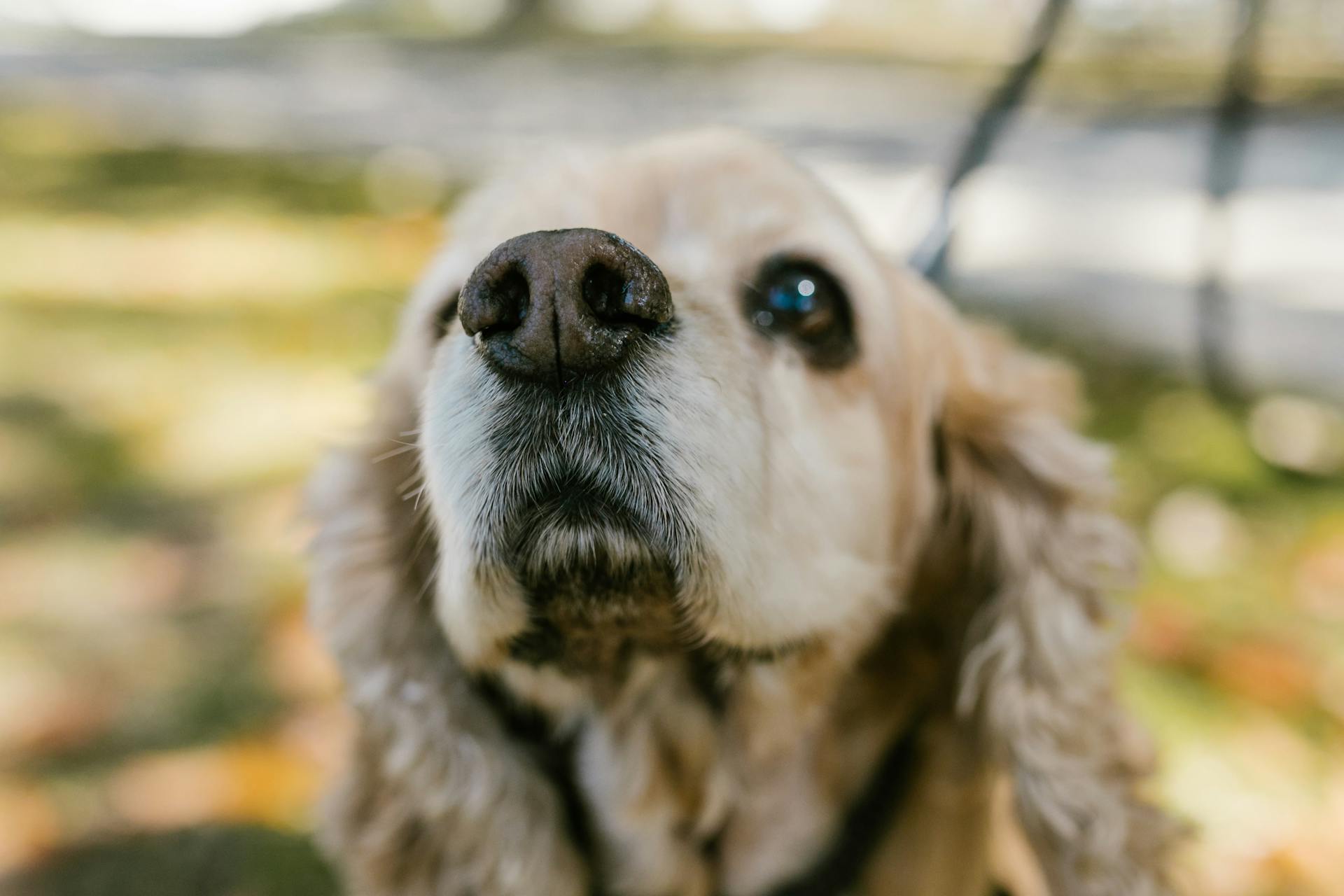
A dog's tracheal collapse sound is often described as a harsh, honking cough or a loud, wheezing sound. This occurs when the trachea, or windpipe, collapses partially or completely, causing a blockage in the airway.
This condition is more common in small and toy breeds, such as Poodles and Chihuahuas. They are more prone to tracheal collapse due to their narrow tracheal diameter.
The sound of a dog's tracheal collapse is often triggered by physical activity, excitement, or even just a slight cough. This can cause the trachea to collapse further, leading to more severe symptoms.
As the trachea collapses, it can cause a range of symptoms, including difficulty breathing, panting, and a blue-tinged tongue.
What is Tracheal Collapse?
Collapsing trachea is a serious condition that affects countless dogs every year. It most often occurs in older, small breeds such as Pomeranians, Terriers, and Pugs.
The trachea, or windpipe, relies on flexible rings of cartilage to keep it open for the air to pass through. These rings become weakened over time.
This weakening allows the trachea to flatten whenever your dog inhales. The condition can progress from grade 1 to grade 4 if left untreated.
In grade 1, the tracheal collapse is an uncomfortable annoyance.
Signs and Symptoms
A dry, honking cough is the top sign of a collapsed trachea in dogs, often sounding like a honking goose. This cough can be triggered by various situations, including excitement, eating, and drinking.
The cough may worsen at night, and dogs may experience episodes of respiratory distress, characterized by frequent and violent coughing. These episodes can last for several minutes but usually resolve on their own.
Other symptoms of collapsing trachea in dogs include severe panting, fainting, and mucous membranes turning a bluish color. Fever is not typically seen in dogs with a collapsed trachea.
Dogs with a tracheal collapse may also exhibit wheezing or difficulty breathing, low energy, rapid breathing or panting, and bluish gums. Fainting and vomiting or gagging from coughing are also possible symptoms.
Here are some common symptoms of tracheal collapse in dogs:
- Dry cough with typically no nasal discharge
- Honking sounds when coughing
- Vomiting or gagging that accompanies coughing
- Difficulty breathing (may show up as panting)
- Unusual breathing sounds
- Lethargy or tiredness with no activity
- Blue discoloration of mucous membranes (gums and mouth)
Collapsed Trachea in Dogs
Collapsed trachea in dogs is a serious condition that affects countless dogs every year. It's most often seen in older, small breeds like Pomeranians, Terriers, and Pugs.
The trachea, or windpipe, relies on flexible rings of cartilage to keep it open for the air to pass through. When these rings become weakened, it allows the trachea to flatten whenever your dog inhales.
The most common symptom of a collapsing trachea in dogs is a chronic dry cough that lasts a few minutes before resolving by itself. This cough is often described as sounding like a goose honk.
Other symptoms to watch out for include wheezing or difficulty breathing, low energy, rapid breathing or panting, bluish gums, fainting, and vomiting or gagging from coughing.
Here are the different stages of tracheal collapse:
Each stage brings an elevated set of symptoms, and if left untreated, the condition can progress to grade 4 where breathing becomes very difficult or even impossible.
What Is a Collapse?
Collapsing trachea is a serious condition that affects countless dogs every year. It can happen to any dog, regardless of size or age.
The trachea relies on flexible rings of cartilage to keep it open for the air to pass through. These rings become weakened over time.
In the early stages of collapse, known as grade 1, it's an uncomfortable annoyance for your dog. They may experience difficulty breathing due to the trachea flattening whenever they inhale.
If left untreated, the condition can progress to grade 4, where breathing becomes very difficult or even impossible.
Collapsed Trachea in Dogs
A collapsed trachea in dogs is a serious condition that affects countless dogs every year. The trachea, or windpipe, relies on flexible rings of cartilage to keep it open for the air to pass through.
The condition is more common in older, small breeds such as Pomeranians, Terriers, and Pugs, but it can happen to any dog regardless of size or age. Each stage of tracheal collapse brings an elevated set of symptoms, including respiratory issues, anxiety, and other organ or system problems.
The symptoms of tracheal collapse in dogs depend on the stage of the condition and the affected dog's overall health. The most common signs include a dry cough with no nasal discharge, honking sounds when coughing, and vomiting or gagging that accompanies coughing.
A dog with a collapsed trachea may experience different episodes where their difficulty in breathing is more apparent than usual. These episodes may be temporary and the intense symptoms may dissipate shortly after, but it's essential to contact a vet to prevent future episodes.
The different grades or stages of canine tracheal collapse are outlined below:
Each stage brings an elevated set of symptoms, and it's essential to seek timely treatment to reduce the occurrence of these episodes. If left untreated, the condition can progress to grade 4, where breathing becomes very difficult or even impossible.
Treatments and Medication
Dog tracheal collapse can be a challenging condition to manage, but the right treatment approach can make a big difference. Medication options are available to help relieve persistent cough, reduce inflammation, and alleviate anxiety and stress.
Oral and injectable medications can be prescribed to manage tracheal collapse symptoms. However, the specific medications and dosage options may vary depending on the individual case.
Environmental management is crucial in reducing pressure on the windpipe and keeping irritants at bay. This can be achieved by using a harness instead of a collar, preventing exposure to smokers around the home, and improving air quality inside the home.
Corticosteroids can be used to reduce swelling and inflammation in dogs with tracheal collapse. However, they may not be effective for all types of tracheal collapse, especially those caused by chronic lung disease.
Your veterinarian can help determine the best course of action for your dog, taking into account their weight, age, and general health. They can also explain the pros and cons of using corticosteroids and other medications to treat tracheal collapse.
Frequently Asked Questions
How long can a dog live with a collapsing trachea?
With proper management and treatment, a dog with a collapsed trachea can live a normal life span. Close monitoring and a tailored treatment plan with a veterinarian are key to managing the condition
How do you comfort a dog with a collapsed trachea?
Comforting a dog with a collapsed trachea involves creating a smoke-free environment and using a chest harness to ease breathing. Additionally, maintaining a healthy weight can also help reduce respiratory effort and alleviate symptoms
How to tell if a dog has a collapsed trachea?
Watch for signs like difficulty breathing, coughing when lifting or applying pressure, and wheezing, which can indicate a collapsed trachea in your dog. If you notice any of these symptoms, consult a veterinarian for proper diagnosis and treatment
What does a dog with collapsing trachea sound like?
A dog with collapsing trachea may produce a harsh, dry, and persistent cough, often described as a 'goose-honking' sound. This cough can be a warning sign of a serious condition, so it's essential to consult a veterinarian if you notice any unusual breathing sounds in your dog
What are the stages of tracheal collapse?
Tracheal collapse has three stages: a mild condition with no symptoms, a mild-to-moderate stage with wheezing and heavy breathing, and a serious condition requiring immediate treatment. Understanding these stages is crucial for prompt diagnosis and treatment.
Sources
- https://www.acvs.org/small-animal/tracheal-collapse/
- https://www.akc.org/expert-advice/health/collapsed-trachea-in-dogs/
- https://www.dailypaws.com/dogs-puppies/health-care/dog-conditions/collapsed-trachea-in-dogs
- https://animalcarecentersmyrna.com/what-is-collapsing-trachea-in-dogs-how-to-recognize-and-treat-it/
- https://www.dutch.com/blogs/dogs/collapsed-trachea-in-dogs
Featured Images: pexels.com


